Protea aurea subsp. aurea
Protea aurea (Burm.f.) Rourke subsp. aurea
Family: Proteaceae
Common names: shuttlecock sugarbush, common shuttlecock sugarbush, long-bud sugarbush, candles (Eng.), geelsuikerbos, geelsuikerkan, langsuikerkan, langknopsuikerbos, kerse (Afr)
SA Tree No: 90.3
Introduction
A tall, upright shrub with iconic cream or pink flower heads in summer and autumn, that resemble candles when in bud and look like a shuttlecock when open. The flowers feed birds and bees with abundant nectar and pollen, making it a decorative and ecologically beneficial garden ornamental.
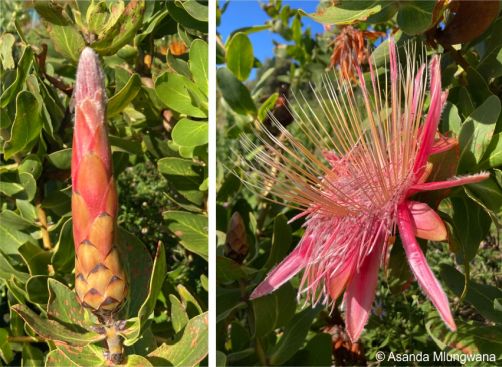
Description
Description
Protea aurea subsp. aurea is a large, evergreen shrub or small tree typically reaching heights of 2–5 m, with a dense, upright growth habit and a single-stemmed main trunk. The stems can be either hairy or smooth. The leaves are oblong to oval, and smooth (without hairs). The flower head is cylindrical in bud, becoming broadly cone-shaped when open, 90–120 mm long. The bracts around the flower head range in colour from creamy green to whitish to pink to crimson, with a silky texture on the outside. The outer bracts are oval, pointed at the tip, and about 15 mm long and wide. The inner bracts are longer and narrower, measuring 40–90 mm in length and 5–14 mm in width. The perianth (the outer parts of the flower) is 90–110 mm long, with a 10 mm tube at the base, and its tips are covered in fine hairs. The style (the stalk that connects the stigma to the ovary) is straight and measures 85–105 mm long. The pollen presenter (the part that holds the pollen) is thread-like, 17 mm long, and slightly bent near the base. Flowering occurs mainly from midsummer to early winter (January to June).
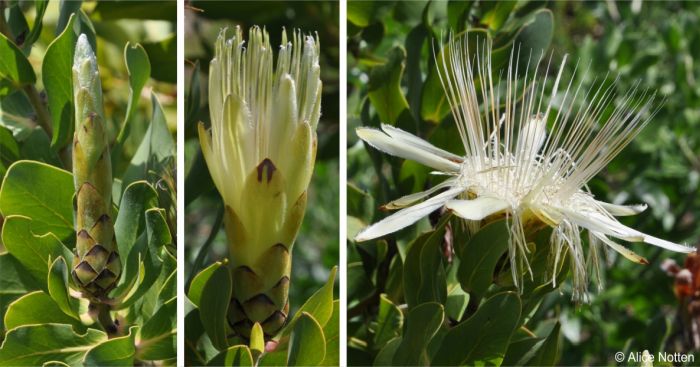
Conservation Status
Status
Protea aurea subsp. aurea is assessed as Least Concern (LC) on the Red List of South African Plants. Although it has lost about 11% of its habitat to farming and timber plantations, it is still widespread and common, and relatively safe in the rest of its habitat. However, urban development and expansion, and the spread of invasive alien plant species pose future risks.
Distribution and habitat
Distribution description
This subspecies is endemic to the Riviersonderend, Langeberg and Outenqua Mountains, growing in South and North Outeniqua Sandstone Fynbos, South and North Langeberg Sandstone Fynbos, South and North Sonderend Sandstone Fynbos, Hawequas Sandstone Fynbos, Greyton Shale Fynbos, Breede Shale Fynbos and Swellendam Silcrete Fynbos. It thrives on cool, moist, south-facing slopes at elevations of 200–1 600 m, often forming dense stands.
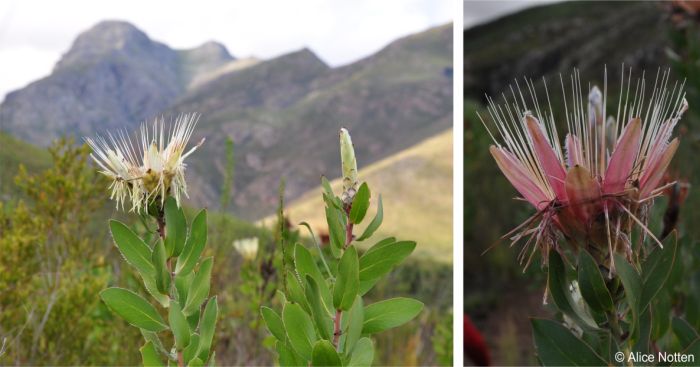
Derivation of name and historical aspects
History
The Proteaceae is a large and diverse family of flowering plants found mostly in the Southern Hemisphere, with nearly 80 genera and approximately 1 700 species. The family is especially diverse in South Africa, particularly in the Cape Floristic Region, and in Australia. Carl Linnaeus, the father of taxonomy, named the Protea genus after Proteus, the mythological Greek god who spoke the truth and could see the future, and was able to change himself into a wide variety of forms, as proteas are also able to. The genus includes about 100 species, all native to Africa, with the highest diversity in South Africa. It is a cornerstone of the Fynbos Biome, contributing significantly to the biodiversity and ecological functioning of this unique vegetation type. The species name aurea comes from the Latin word aureus, meaning ‘golden’, referring to the yellowish hues of the involucral bracts in dried flower heads; this name was given by the Dutch botanist Nicolaas Laurens Burman in 1768, who was working from dried herbarium specimens and may have thought that they were also yellow when fresh.
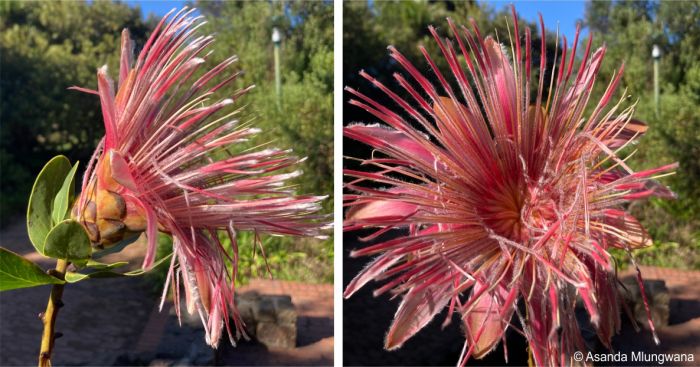
Ecology
Ecology
Through its nectar-rich flowers, this subspecies plays a vital role in supporting pollinators, including birds, insects and mammals. Its large, colourful flower heads produce abundant nectar, which serves as a key resource for pollinators. Sunbirds and Cape Sugarbirds are the primary pollinators. The secondary pollinators that contribute to the genetic diversity of populations by cross-pollination are beetles, bees and other insects.
Proteas are adapted to grow in very nutrient-poor soils, and have evolved very sensitive roots, termed proteid roots, that form a dense mat near the soil surface, and are able to absorb the tiny amounts of nutrients that are available.
The hairy seeds of Protea aurea subsp. aurea are dispersed by the wind, allowing for colonization of nearby suitable habitats. The seeds are nuts, and are eaten by various animals, and some small mammals, such as mice, may inadvertently aid in seed dispersal by burying the seeds in underground caches and leaving them uneaten for future needs, but from the plant’s point of view they are now safely buried and waiting for the right conditions to trigger germination. This subspecies is termed a reseeder, as it is killed by fire and regenerates from seeds stored in the soil or in the fire-resistant seed heads in the canopy that are released after the fire, rather than resprouting from a surviving rootstock. Fire plays an indispensable ecological role for Protea aurea subsp. aurea, as it stimulates seed release and germination.
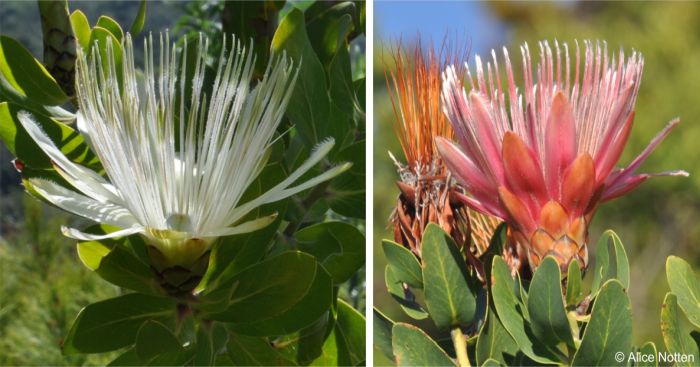
Uses
Use
Although not widely used, Protea aurea subsp. aurea is easy to grow and fast-growing and is ideal for south- or east-facing slopes in fynbos gardens. The large, colourful flower heads and decorative foliage make it a striking feature in gardens.
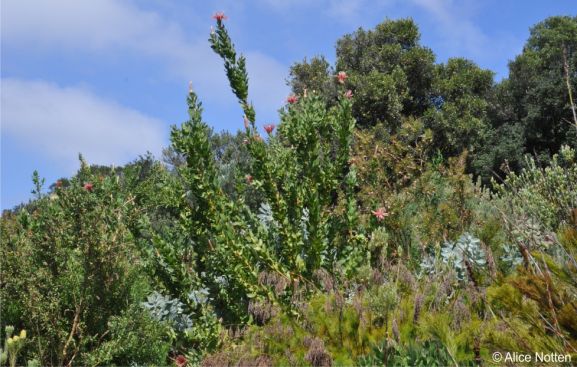
Growing Protea aurea subsp. aurea
Grow
Protea aurea subsp. aurea can be propagated from seed or from cuttings.
Seed Propagation: Collect seeds a year after the flower heads have dried on the plant to give the seeds time to mature. For best results, treat seeds with smoke water or a smoke primer to break dormancy, simulating the effects of fire in the natural habitat. Sow in autumn, in a well-drained fynbos mix consisting of 1 part loam, 1 part bark, and 2 parts sand and cover with seeds and cover the seeds lightly with sand or fine-milled bark. Germination typically takes 3–6 weeks. Avoid waterlogging by maintaining moderate moisture levels and place in an area with free air circulation. Seedlings are fast-growing and flowering can be expected from when they are one year old.
Cuttings: Take semi-hardwood cuttings, 60-100 mm long, during late summer from the current season’s growth. Dip the cuttings into a rooting hormone to enhance success rate and plant in a mixture of 50% polystyrene and 50% bark. Place the cuttings under intermittent mist with a bottom heat of 25°C and in a house with good air circulation. Rooting requires a mist unit or high humidity environment.
For optimal growth, this plant requires full sun and prefers acidic, sandy soil with good drainage. Once established, it is drought-tolerant but benefits from watering during extended dry periods. A well-ventilated environment and well-drained, undisturbed soil conditions are an essential factor in preventing disease in proteas. Fertilize with well-rotted compost added as a mulch or use low-doses of slow-release organic fertilizers and avoid over-fertilization, especially with phosphorus, as proteas are sensitive to it. Companion plants include other fynbos species like restios and ericas, which share similar water and soil requirements.
References
- Nndanduleni, M. 2016. Protea longifolia Andrews (Proteaceae). PlantZAfrica. Online. https://pza.sanbi.org/protea-longifolia.
- Nurrish, L. 2009. Protea aurea (Burm.f.) Rourke subsp. potbergensis Rourke (Proteaceae). PlantZAfrica. Online. https://pza.sanbi.org/protea-aurea-subsp-potbergensis.
- Protea Atlas Project. Protea Atlas data sheets: Protea aurea subsp. aurea https://www.proteaatlas.org.za/PROTEA_ATLAS_Protea3.pdf. Accessed on 11 December 2024.
- Rebelo, A.G., Mtshali, H. & von Staden, L. 2020. Protea aurea (Burm.f.) Rourke subsp. aurea. National Assessment: Red List of South African Plants. http://redlist.sanbi.org/species.php?species=799-12.
- Rebelo, A.G. 2001. Proteas. A field guide to the proteas of southern Africa. Fernwood Press, Vlaeberg, Cape Town.
- Rourke, J.P. 1980. The Proteas of southern Africa. Purnell. Cape Town.
Credits
Asanda Mlungwana and Alice Notten
Kirstenbosch National Botanical Garden
January 2025
Plant Attributes:
Plant Type: Shrub
SA Distribution: Western Cape
Soil type: Sandy, Loam
Flowering season: Late Summer, Autumn, Winter
PH: Acid
Flower colour: Green, White, Pink, Cream
Aspect: Full Sun, Morning Sun (Semi Shade), Afternoon Sun (Semi Shade)
Gardening skill: Easy
Special Features:
Horticultural zones
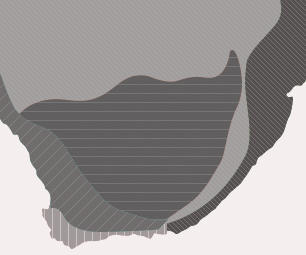







Rate this article
Article well written and informative
Rate this plant
Is this an interesting plant?
Login to add your Comment
Back to topNot registered yet? Click here to register.